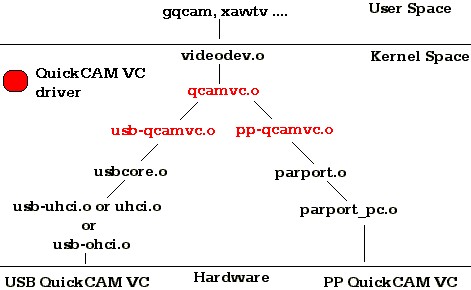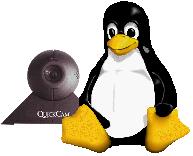Installation
This driver need the usb/parallel and videodev support on a V2.4.x kernel (look the modules tree in this section). Early versions of the Linux kernel are not supported.
This document describe how to install the QuickCam VC driver from version 1.0.6.
The driver is distribuited as a kernel patch; so you must be able to patch, configure and compile the linux kernel.
Consider to use a linux vanilla kernel from www.kernel.org. Any other commercialized version of the kernel (Mandrake, RedHat, Suse, etc) are not currently considered and supported; it will be when asked.
After the kernel patch, during configuration, you must select the support for USB and/or Parallel. In the Video4Linux section select your QuickCam VC model.
I suggest to compile that supports as modules. If you find problems on modules look in the Documentation directory of the kernel sources tree.
After booting the new kernel you are ready to load the quickcam module with "modprobe qcamvc". The driver is organized with an communication indipendent module (qcamvc) and two low level modules (usb-qcamvc and pp-qcamvc) that connect the first module to the cams through the Parport or the USB. Run a video4linux client like gqcam and try to grab an image file.
Modules Tree

Module Configuration
Using modules requires a bit of work to install and pass the parameters. Read the $kernel_dir/Documentation/modules.txt, and understand that entries in /etc/modules.conf of:
Devices Configuration
Video4linux use the /dev/video* files, and the driver need one per camera.
In this package you find the script "make_devices" that automatically create the device files.
Run a Video4linux client program
I suggest GqCam.
This driver need the usb/parallel and videodev support on a V2.4.x kernel (look the modules tree in this section). Early versions of the Linux kernel are not supported.
This document describe how to install the QuickCam VC driver from version 1.0.6.
The driver is distribuited as a kernel patch; so you must be able to patch, configure and compile the linux kernel.
Consider to use a linux vanilla kernel from www.kernel.org. Any other commercialized version of the kernel (Mandrake, RedHat, Suse, etc) are not currently considered and supported; it will be when asked.
After the kernel patch, during configuration, you must select the support for USB and/or Parallel. In the Video4Linux section select your QuickCam VC model.
I suggest to compile that supports as modules. If you find problems on modules look in the Documentation directory of the kernel sources tree.
After booting the new kernel you are ready to load the quickcam module with "modprobe qcamvc". The driver is organized with an communication indipendent module (qcamvc) and two low level modules (usb-qcamvc and pp-qcamvc) that connect the first module to the cams through the Parport or the USB. Run a video4linux client like gqcam and try to grab an image file.
Modules Tree

Module Configuration
Using modules requires a bit of work to install and pass the parameters. Read the $kernel_dir/Documentation/modules.txt, and understand that entries in /etc/modules.conf of:
alias char-major-81 videodevIf you are using kmod or kerneld, then a request for a 'char-major-81-0' will cause the 'qcamvc' module to load. If you have other video sources with modules, you might want to assign the different minor numbers to different modules.
alias char-major-81-0 qcamvc
Devices Configuration
Video4linux use the /dev/video* files, and the driver need one per camera.
ls -lad /dev/video* # produce a list of the video devicesIf the video devices do not exist, you can create them with this shell script:
suThe important part is to make the proper special character files with the right major and minor numbers. All of the special device files are listed in ../devices.txt. If you would like the quickcam usable by non-root users, you will need to change the permissions.
cd /dev
for ii in 0 1 2 3 4 5 6 7 8 9 10 11 12 13 14 15 16 ; domknod video$ii c 81 $ii # char-major-81-[0-16]done
chown root.root video$ii # owned by root
chmod 600 video$ii # read/writable by root only
In this package you find the script "make_devices" that automatically create the device files.
Run a Video4linux client program
I suggest GqCam.
24 May 2003
